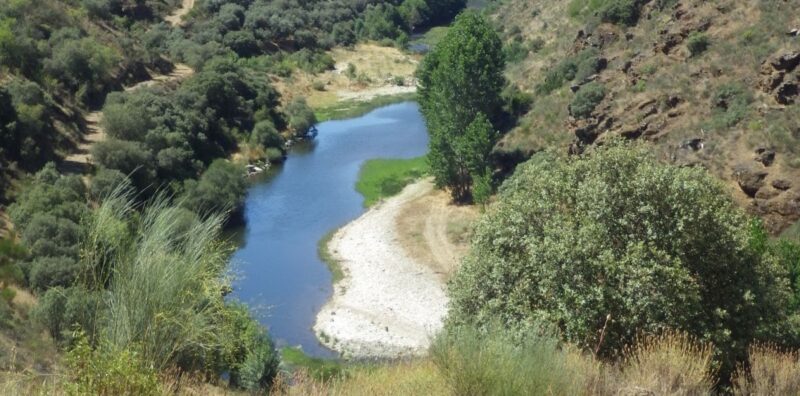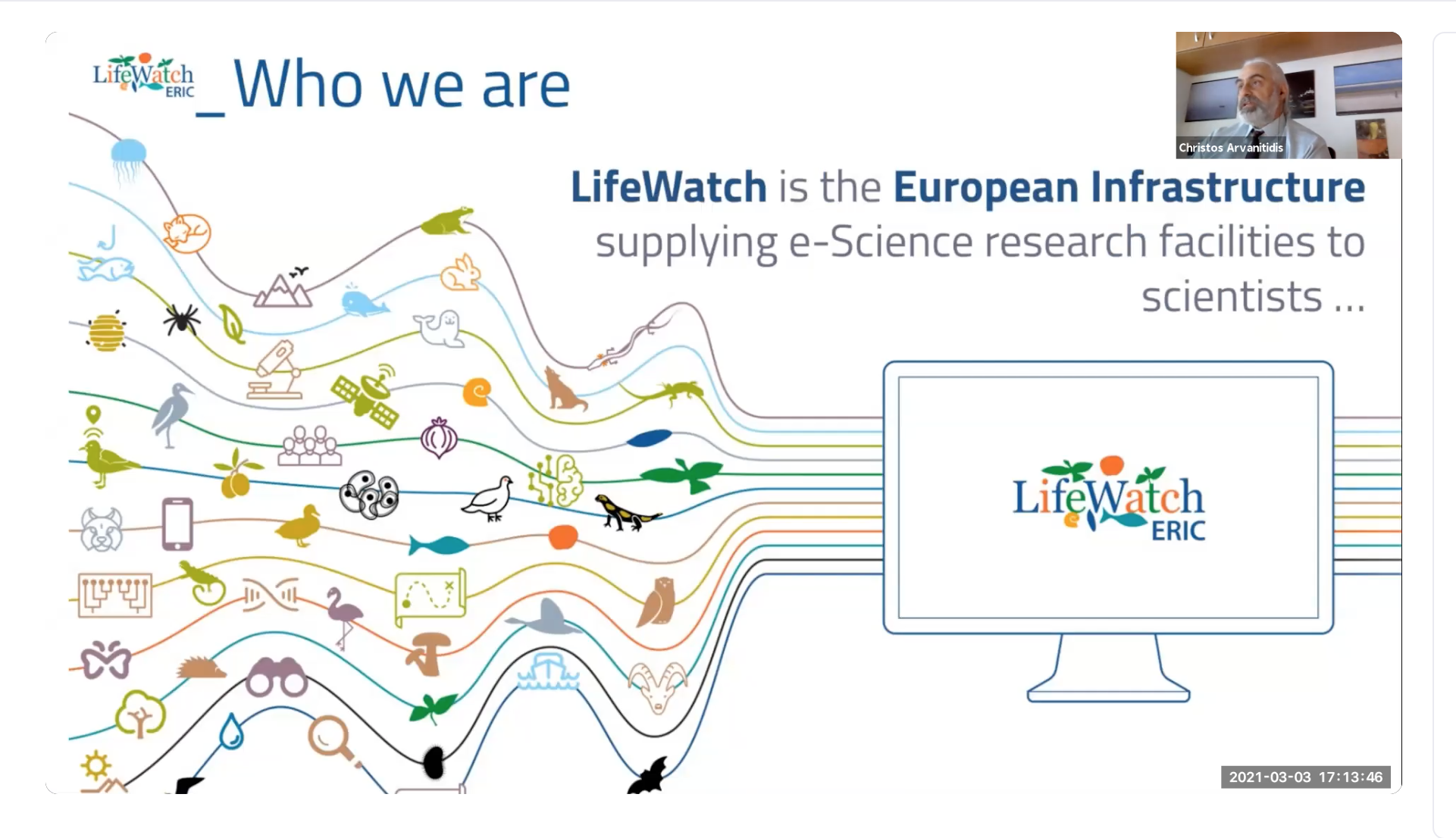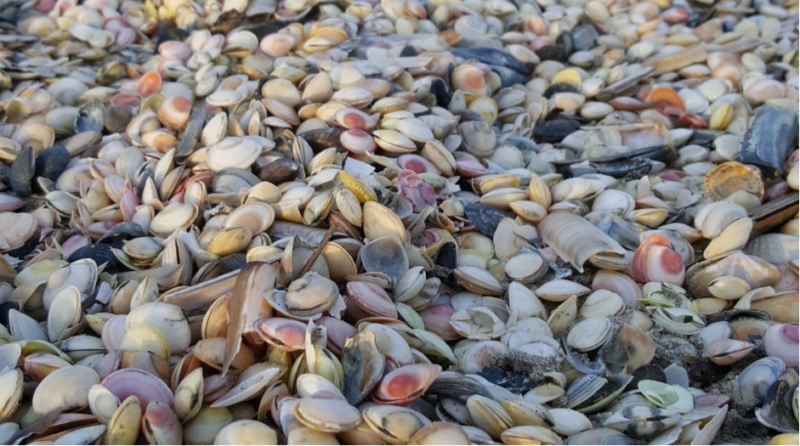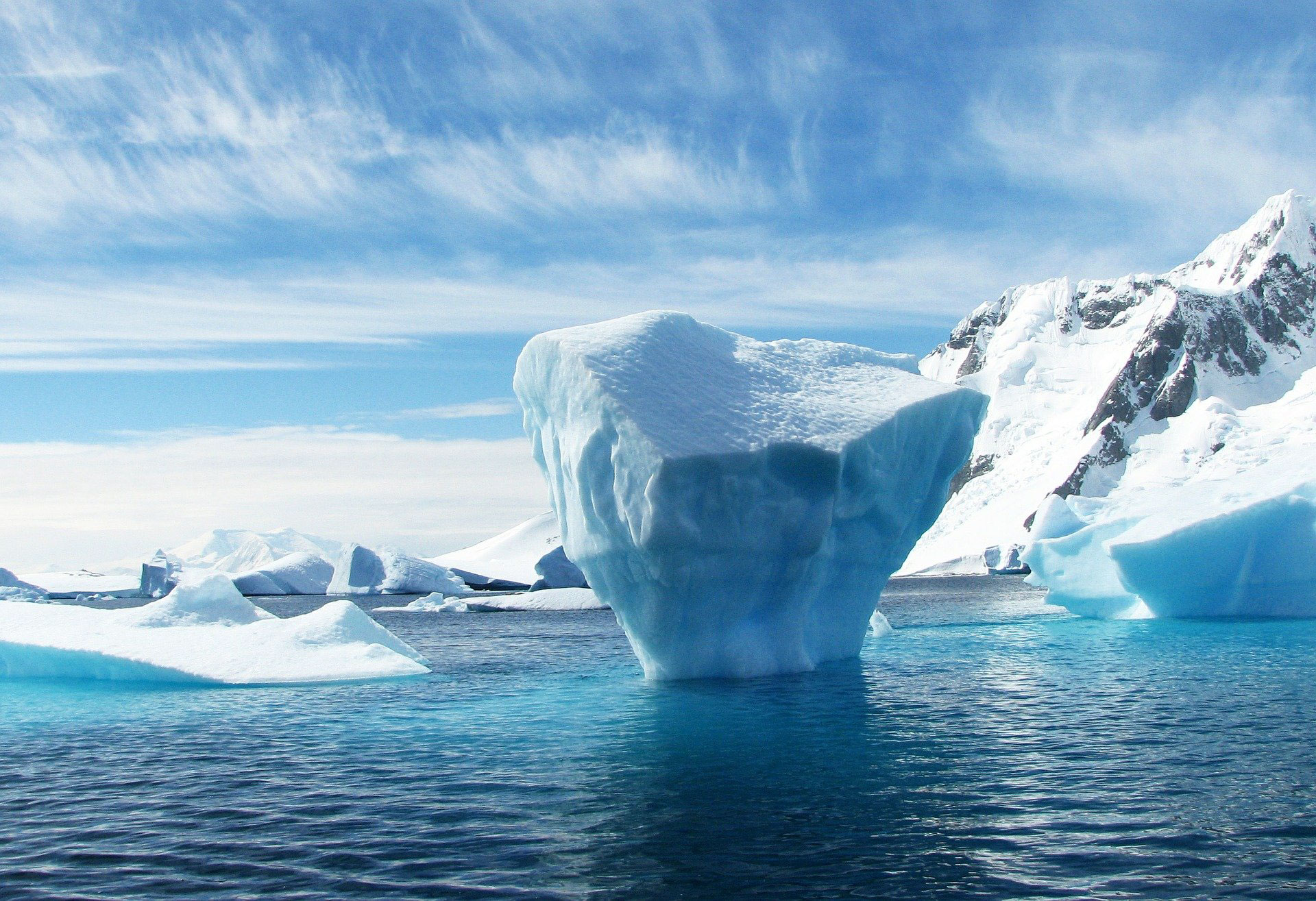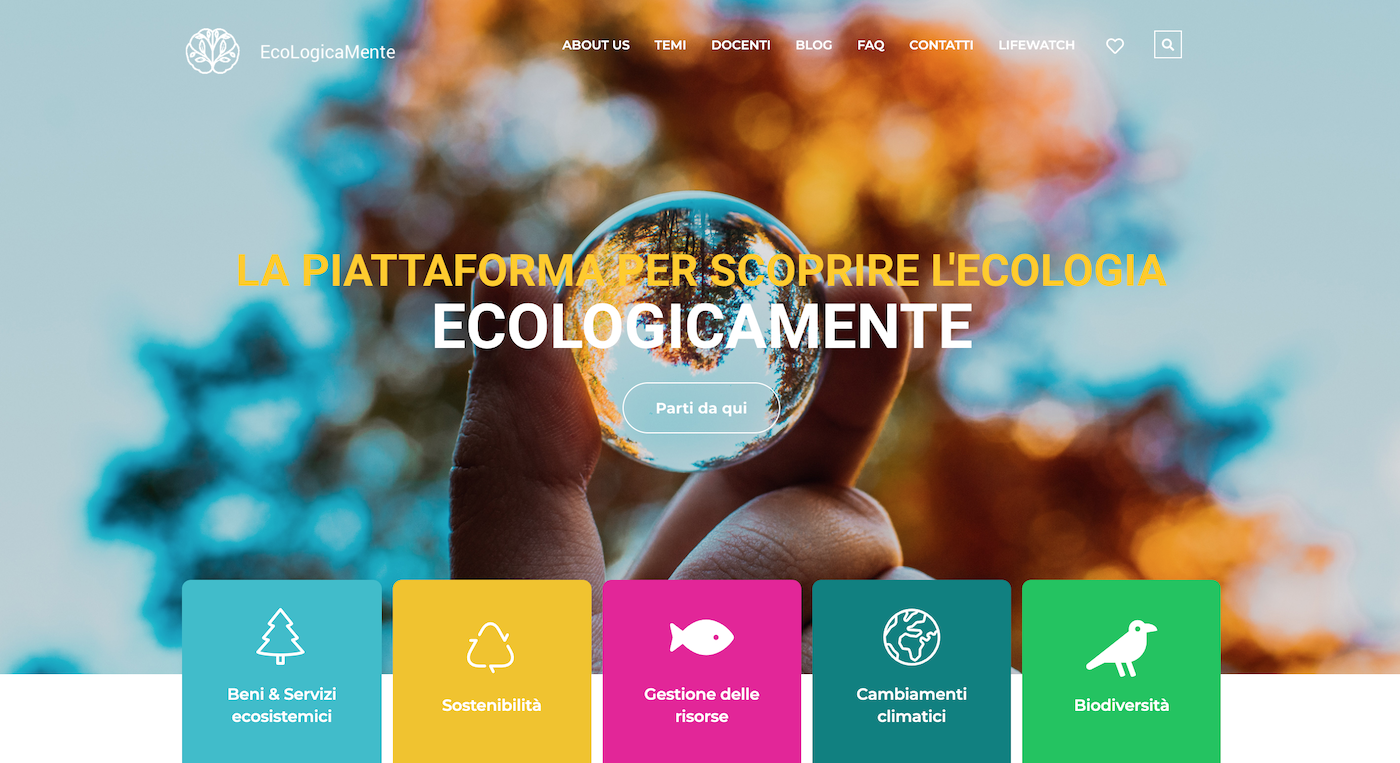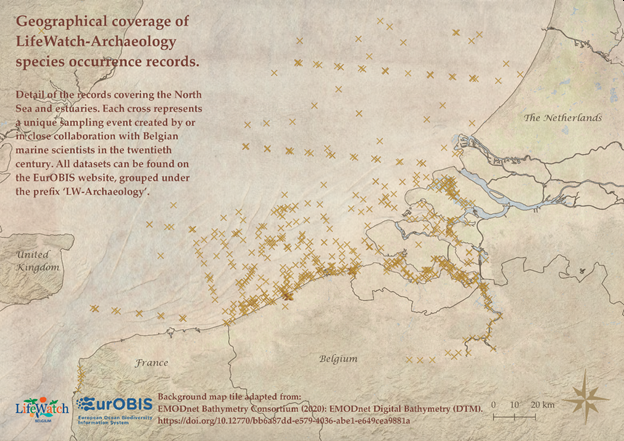study from 2012 to 2019 in the Sabor river in northeast Portugal focused on stream fish affected by hydropower development. Trajectory analysis was used to quantify the directionality and velocity of community change across 30 sites, and geometric modelling provided a simple framework to understand where and why temporal community dynamics vary across dendritic stream networks.
Continue readingLifeWatch ERIC Presentation at University of Cyprus
LifeWatch ERIC Chief Executive Officer, Christos Arvanitidis, gave an online presentation to the Department of Biological Sciences at the University of Cyprus on 3 March 2021. The Zoom session was recorded and provides a convenient overview of LifeWatch ERIC’s mission, recent developments and what it offers to the scientific community studying the impacts of climate change in biodiversity and ecosystem research.
Dr Arvanitidis, who previously worked at Hellenic Centre for Marine Research, explained that research infrastructures do not do the research themselves, they supply the means for others to pursue their research. LifeWatch ERIC is a European consortium that provides e-Science research facilities so that we can all arrive at a deeper understanding of biodiversity organisation and ecosystem functions and services. In particular, the infrastructure allows access to:
- Open Data, also known as FAIR-compliant data, through innovative technologies;
- Reproducible analytics, so that workflows can be verified; and
- Mobilised communities, helping scientists to work across disciplines around the globe.
The seminar was introduced by Dr Vasilis Promponas, Head of the Bioinformatics Research Laboratory at the Department of Biological Sciences at the University of Cyprus, whose research interests include large scale comparative genomics, a field that stands to benefit from the tools and service available through the LifeWatch ERIC portal. The University of Cyprus is a public research university established in Nicosia in 1989, which offers a range of courses to over 7000 students.
Please click here to access the CEO’s presentation.
‘Baltic tellin’ Queen of the 4th Belgian Big Seashell Survey
On Sunday 14 March 2021, the fourth edition of the Big Seashell Survey took place along the Belgian coast as part of the LifeWatch programme.
Continue readingCEO at the Pefkoxori Primary School
A group of students at the Pefkoxori Primary School were delighted on Friday 5 March 2021, when Christos Arvanitidis, Chief Executive Officer of LifeWatch ERIC, came online to talk to them about the biodiversity of wetlands.
Continue readingLife in the North Sea is becoming more exotic
A recent study of 14 national and international institutions – the “VLIZ Alien Species Consortium” – revealed the presence of 79 exotic (alien) marine and brackish species in the Belgian part of the North Sea and the Scheldt estuary. This translates to a 15% increase in alien species in these areas over the past decade (2012-2020). An increase in intercontinental shipping, a better monitoring of these species, and movement of species for aquaculture purposes are all likely explanations.
The VLIZ Alien Species Consortium compiled their findings in a book, and factsheets for all 79 exotic species are available through their website (both book and website are only available in Dutch).
The taxonomic information and alien distributions of these 79 Belgian alien species are also available through the Belgian Register of Marine Species (BeRMS) and the World Register of Introduced Marine Species (WRiMS), both sub-registers of the World Register of Marine Species (WoRMS). WoRMS, WRiMS and BeRMS are all contributors to the LifeWatch Species Information Backbone.
By compiling taxonomic information, native and alien distributions, and other relevant information (such as e.g. invasiveness, impact, pathways of introduction), the LifeWatch Species Information Backbone offers scientists and policy makers the needed information to analyze the current situation and to work towards possible prevention measures to stop further introductions and spreading of these species. All of this – linked to the currently maintained ‘Watch-list’ that keeps track of potential new introductions in the area – can lead to the set-up of a fast detection system and the development of a control and management framework.
See the Complete Species List here.
ENVRI Community International Winter School 2021
The 2021 ENVRI Community International Winter School from 11–22 January attracted 32 participants from all around the world, predominantly data centre staff, researchers and PhD candidates. Centred on the FAIR principles of data management, the online curriculum covered semantic navigation, Jupyter environments for visualisation and data discovery, resource access tools and cloud computing.
In recognition of the difficulties of distance learning, the organisers structured 40 hours of presence (including preparations) over a two-week period, with scheduled lectures and presentations in the mornings (09-11), followed by associated group and individual work time (11-12). The relevance of the content to the participants’ work ensured a high level of commitment and a great sense of camaraderie developed.
FAIR data are data which meet the principles of findability, accessibility, interoperability and reusability. The presentation of real-life use cases using state-of-the-art technologies demonstrated how essential it is to support end users in making the best use of the data, and to develop good user interfaces and services. The time the participants spent together created a new knowledge-exchange network for these data professionals. The team of teachers behind the “ENVRI-FAIR Resources: Access & Discoverability” Winter School was also international, with up-to-the-minute experience in the application of new technologies to enhance data centre functionality.- Dr Antonio José Sáenz-Albanés (ICT Infrastructure Operations Coordinator at LifeWatch ERIC) and Dr José Maria García-Rodriguez (Associate Professor of Applied Software Engineering at the University of Seville) dealt with how semantics enrich data resources and increase their FINDability by making them machine-actionable;
- Dr Ute Karstens and Dr Claudio Onofrio, respectively researcher and data scientist at Lund University, Sweden, gave a presentation on a fully integrated VRE application at ICOS Carbon Portal, called the atmospheric transport model STILT, running through a full life cycle for an ‘on demand’ model and visualising results as an interactive map;
- Dr Karolina Pantazatou and Ida Storm also work at ICOS Carbon Portal, Lund University, as scientific programmer and project assistant. Their workshop on using GIS-tools and Python-programming and user friendly Jupyter notebooks that process and analyse ICOS data products, had students tweeting in delight: “What a great workspace to document (text, images, links), write code & visualize data -all open and shareable!”;
- ICT Coordinator at the LifeWatch ERIC Service Centre, Nicola Fiore, and Web Portal Officer at the LifeWatch ERIC Service Centre, Lucia Vaira, kicked off the second week with a presentation on the LifeWatch ERIC Metadata Catalogue, explaining the entire process behind the creation and publication of new resources and how to access them; and
- Dr Zhiming Zhao, assistant professor at the University of Amsterdam, used examples from the ENVRIplus and ENVRI-FAIR projects to illustrate how to develop and operate data management services in cloud environments, from running a legacy and native cloud applications, to automating their deployment. Students were able to practice on the cloud infrastructures at EOSC and LifeWatch. One student tweeted a quote: “Users don’t care about the technology you use, but its quality and usefulness”.
The final presentations allowed participants to demonstrate just how much they had learned in professional terms, but there was no sad goodbye at the end. Students had been given the recipe for pasticciotti, the characteristic Lecce pastry, the week before, and everyone cheered as the winner of the ENVRI Chef Challenge was announced. The final tweet? “I highly recommend @ENVRIcomm open training resources!”
EU-AFRICA e-Biodiversity & Ecosystem Sustainable Management in support of GeoScience
LifeWatch ERIC Chief Technology Officer Juan Miguel González-Aranda participated as speaker and in the discussions at a workshop co-organised on 22 January 2021 by The Science Foundation Ireland Research Centre for Applied Geosciences (iCRAG) and the Council for Geoscience of South Africa to present a vision for a shared EU-Africa Geoscience Infrastructure.
The meeting was organised as part of the AERAP EU-Africa science collaboration platform, aimed at providing input for the forthcoming EU-Africa summit during the Portuguese Counsel Presidency. Although the summit date has yet to be finalised, the EU Strategy for Africa and the launch of Horizon Europe and the Neighbourhood, International Cooperation and Development Instrument (NDICI) can benefit from contributions from the EU and African geosciences communities.
In line with UN Sustainable Development Goal 17, “partnerships for the goals”, the African Union’s Agenda 2063 for socio-economic transformation and the European Commission’s Africa Strategy call for partnerships to achieve common goals. The foundation for a strong and enduring partnership needs to be rooted in our shared Earth, and informed by the knowledge of what science and technology can deliver. Justly achieving the green transition and the digital transformation while delivering the United Nations Sustainable Development Goals requires a full understanding of our planet home.In fact, Earth sciences provide solutions for many aspects underpinning the European Green Deal and the circular economy, including water security, agricultural sustainability, energy security, raw materials availability, especially as regards the critical minerals necessary for decarbonisation, the blue economy, and community safety from geohazards including climate change. The revolution in earth sciences brought about by the Big Data generated through AU-EU research partnerships will require additional distributed ICT e-Infrastructures in Africa and Europe, and the development of data analysis and management skills, especially for younger generations and particularly women.
An AU-EU partnership in earth sciences is being leveraged by expanding the existing cooperation between the Organization of African Geological Surveys (OAGS) and the European Geological Surveys (EGS), such as PanAfGeo which has been ongoing since 2016. At Friday’s meeting, Dr González-Aranda presented LifeWatch ERIC as a distributed ICT e-Infrastructure which is already providing support to address the primary challenges outlined in the European Commission’s comprehensive strategy with Africa, based on the essential relationship between Geodiversity and e-Biodiversity.
EcoLogicaMente
The EcoLogicaMente platform, developed by LifeWatch Italy in partnership with the Italian Society of Ecology (SItE) and University of Salento (UniSalento), is a web-based tool launched in 2021 to allow visitors to explore a broad range of issues in the field of ecology.
Primarily addressed to Italian school students and teachers, from Primary through to High School, the in-depth topics contain various types of material including texts, videos, presentations, live lessons, games, questionnaires, and practical activity sheets for work in the field or in the laboratory.
The EcoLogicaMente study topics and materials have been compiled by university professors and experts on ecological issues and are divided into five macro-areas: Ecosystem goods and services, Sustainability, Resource Management, Climate Change, and Biodiversity.
The courses are divided into different levels all of which require a login, and it is possible to receive a certificate of participation, after completing all the lessons and passing a final test. Support is available through an FAQ page and users can leave a rating of the material available and write reviews. Click here to navigate the platform.LifeWatch ERIC in MSc, University of Crete
LifeWatch ERIC contributed to a Master of Science programme at the Department of Biology at the University of Crete on Tuesday 19 January, 2021. The delivery was naturally online because of Coronavirus restrictions.
LifeWatch ERIC Chief Executive Officer Christos Arvanitidis presented a seminar entitled ‘Introduction to the international, European and national legal framework of the sea’, as part of the Masters of Management of Terrestrial and Marine Resources. Click here to download the PDF.
The Department of Biology at the University of Crete was established in 1981 and is today an internationally recognised centre for contemporary tertiary education and research.
Data Archaeology: 90 new datasets for EurOBIS
The Flanders Marine Institute (VLIZ), founded in 1999, promotes marine knowledge creation and excellence through sound interdisciplinary research about the ocean, seas, coasts and tidal estuaries. Since 2012, the LifeWatch team at VLIZ has processed and digitised over 100 historical biodiversity datasets that were created by, or collected in close collaboration with, Belgian marine scientists.
Over the last year, 90 of these datasets were further refined to become part of the European Ocean Biodiversity Information System (EurOBIS). EurOBIS is an important building block of the LifeWatch Species Information Backbone, a central contribution from LifeWatch Flanders to LifeWatch ERIC, the purpose of which is to centralise biodiversity data and fill the gaps in our knowledge.
Although these data refer to observations made in the twentieth century, investing time in making them available through online systems is highly valuable, as looking at the past will help us to better understand the future. Data archaeology fills in a historical data gap and provides the necessary baseline information for inter alia species distribution and climate change models.
The 90 newly-available datasets mainly cover the North Sea and provide the historical context for present observations, thereby facilitating the process of setting reference conditions for monitoring and management activities in this area. They comprise 305,529 occurrence records of 3,758 different taxa from small meiofauna as well as bigger macrobenthos communities, with the earliest occurrence record dating back to 1903.
The datasets conform to FAIR data principles, ensuring the findability, accessibility, interoperability and reusability of the (meta)data, and have been formatted to the internationally accepted DarwinCore format (DwC), and BODC vocabularies. They are available through the Belgian LifeWatch e-Lab, the EMODnet Biology project (through its Data Catalogue, Data Download Toolbox, web services and IPT), the Ocean Biodiversity Information System (OBIS) and the Global Biodiversity Information Facility (GBIF).
